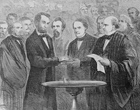In the process of preserving the Union of 1776 while purging it of slavery, the Civil War also transformed it. Before 1861 the words United States were usually rendered as a plural noun: "The United States are a large country." Since 1865 the United States is a large country. The North went to war to preserve the Union; it ended by creating a nation. This transformation can be traced in Lincoln's wartime speeches. The first inaugural address contained the word Union twenty times and the word nation not once. In Lincoln's first message to Congress, on July 4, 1861, he used Union forty-nine times and nation only three times. But in the Gettysburg Address on November 19, 1863, he did not refer to the Union at all but used the word nation five times. Looking back on the past four years in his second inaugural address, on March 4, 1865, Lincoln spoke of one party seeking to dissolve the Union in 1861 and the other accepting the challenge of war to preserve the nation.
The decentralized antebellum republic, in which the post office was the only agency of the federal government that touched the average citizen, was transformed by the crucible of war into a centralized polity that taxed people directly and established an internal revenue bureau to collect the taxes, expanded the jurisdiction of federal courts, enacted a national currency and a federally chartered banking system, drafted men into the army, and created a Freedmen's Bureau as the first national agency for social welfare. Eleven of the first 12 amendments to the Constitution had limited the powers of the national government. Six of the next seven, starting with the 13th Amendment in 1865, radically expanded those powers at the expense of the states. Controversies over federal-state relations and the legitimate powers of the national government have echoed down the years since the Civil War, and are still very much alive today.
Before 1861 two socioeconomic and cultural systems had competed for dominance within the United States: a rural, agricultural, plantation society in the South based on slave labor and a diversified, industrializing, free-labor capitalist society in the North. Although in retrospect the triumph of free-labor capitalism seems to have been inevitable, that was by no means clear during most of the antebellum era. From 1789 to 1861, a Southern slaveholder had been president of the United States for two-thirds of those years. Likewise, two-thirds of the Speakers of the House and presidents pro tempore of the Senate had also been Southerners. Twenty of the 35 Supreme Court justices during that period had been from the South, including the chief justice for 61 of those 72 years. At all times a majority of the Court were Southerners. The territory of the slave states considerably exceeded that of the free states before 1859 and the Southern drive for additional territorial expansion was more aggressive than that of the North. Most of the slave states seceded in 1861 not only because they feared the potential threat to the long-term survival of slavery posed by Lincoln's election, but also because they looked forward to the expansion of a dynamic, independent Confederacy into new territory by the acquisition of Cuba and perhaps more of Mexico and Central America. If the Confederacy had prevailed in the 1860s, it is quite possible that the emergence of the United States as the world's leading industrial, as well as agricultural producer by the end of the 19th century, and the world's most powerful nation in the 20th century might never have happened.



